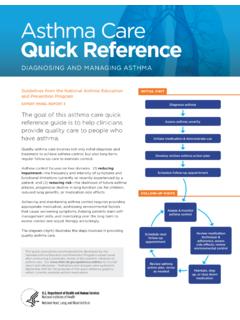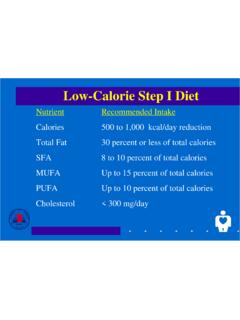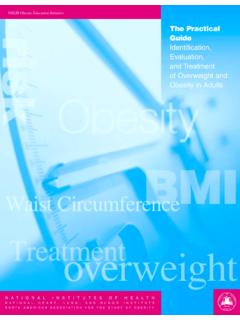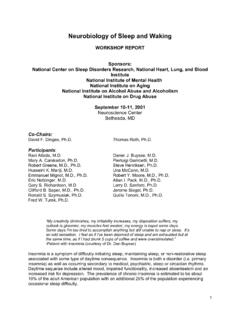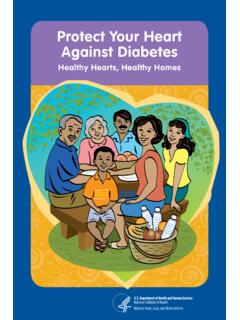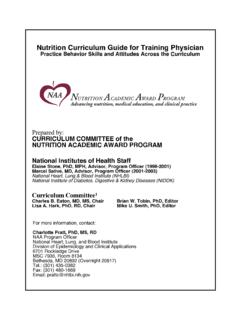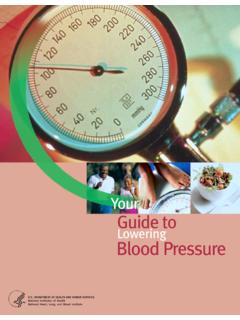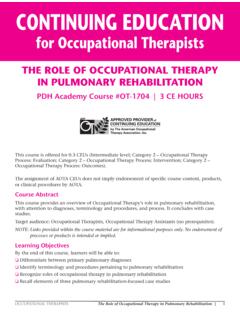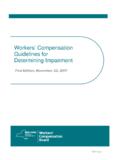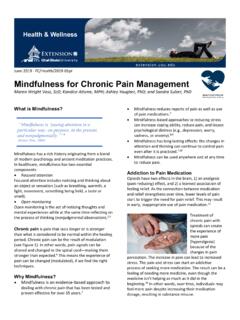Transcription of SECTION 2, DEFINITION, PATHOPHYSIOLOGY AND …
1 SECTION 2, definition , PATHOPHYSIOLOGY and Pathogenesis of Asthma, and Natural History of Asthma 11 August 28, 2007 SECTION 2, definition , PATHOPHYSIOLOGY AND PATHOGENESIS OF ASTHMA, AND NATURAL HISTORY OF ASTHMA KEY POINTS: definition , PATHOPHYSIOLOGY AND PATHOGENESIS OF ASTHMA, AND NATURAL HISTORY OF ASTHMA Asthma is a chronic inflammatory disorder of the airways. This feature of asthma has implications for the diagnosis, management, and potential prevention of the disease. The immunohistopathologic features of asthma include inflammatory cell infiltration: Neutrophils (especially in sudden-onset, fatal asthma exacerbations; occupational asthma, and patients who smoke) Eosinophils Lymphocytes Mast cell activation Epithelial cell injury Airway inflammation contributes to airway hyperresponsiveness, airflow limitation, respiratory symptoms, and disease chronicity.
2 In some patients, persistent changes in airway structure occur, including sub-basement fibrosis, mucus hypersecretion, injury to epithelial cells, smooth muscle hypertrophy, and angiogenesis. Gene-by-environment interactions are important to the expression of asthma. Atopy, the genetic predisposition for the development of an immunoglobulin E (IgE)-mediated response to common aeroallergens, is the strongest identifiable predisposing factor for developing asthma. Viral respiratory infections are one of the most important causes of asthma exacerbation and may also contribute to the development of asthma. SECTION 2, definition , PATHOPHYSIOLOGY and Pathogenesis of Asthma, and Natural History of Asthma 12 August 28, 2007 KEY DIFFERENCES FROM 1997 AND 2002 EXPERT PANEL REPORTS The critical role of inflammation has been further substantiated, but evidence is emerging for considerable variability in the pattern of inflammation , thus indicating phenotypic differences that may influence treatment responses.
3 Gene-by-environmental interactions are important to the development and expression of asthma. Of the environmental factors, allergic reactions remain important. Evidence also suggests a key and expanding role for viral respiratory infections in these processes. The onset of asthma for most patients begins early in life with the pattern of disease persistence determined by early, recognizable risk factors including atopic disease, recurrent wheezing, and a parental history of asthma. Current asthma treatment with anti-inflammatory therapy does not appear to prevent progression of the underlying disease severity. Introduction Asthma is a common chronic disorder of the airways that involves a complex interaction of airflow obstruction, bronchial hyperresponsiveness and an underlying inflammation .
4 This interaction can be highly variable among patients and within patients over time. This SECTION presents a definition of asthma, a description of the processes on which that definition is based the PATHOPHYSIOLOGY and pathogenesis of asthma, and the natural history of asthma. definition of Asthma Asthma is a common chronic disorder of the airways that is complex and characterized by variable and recurring symptoms, airflow obstruction, bronchial hyperresponsiveness, and an underlying inflammation (box 2 1). The interaction of these features of asthma determines the clinical manifestations and severity of asthma (figure 2 1) and the response to treatment. The concepts underlying asthma pathogenesis have evolved dramatically in the past 25 years and are still undergoing evaluation as various phenotypes of this disease are defined and greater insight links clinical features of asthma with genetic patterns (Busse and Lemanske 2001; EPR 2 1997).
5 Central to the various phenotypic patterns of asthma is the presence of underlying airway inflammation , which is variable and has distinct but overlapping patterns that reflect different aspects of the disease, such as intermittent versus persistent or acute versus chronic manifestations. Acute symptoms of asthma usually arise from bronchospasm and require and respond to bronchodilator therapy. Acute and chronic inflammation can affect not only the airway caliber and airflow but also underlying bronchial hyperresponsiveness, which enhances susceptibility to bronchospasm (Cohn et al. 2004). BOX 2 1. CHARACTERISTICS OF CLINICAL ASTHMA Symptoms Airway obstruction inflammation Hyperresponsiveness SECTION 2, definition , PATHOPHYSIOLOGY and Pathogenesis of Asthma, and Natural History of Asthma 13 August 28, 2007 FIGURE 2 1.
6 THE INTERPLAY AND INTERACTION BETWEEN AIRWAY inflammation AND THE CLINICAL SYMPTOMS AND PATHOPHYSIOLOGY OF ASTHMA InflammationInflammationAirway HyperresponsivenessAirway ObstructionClinical Symptoms Treatment with anti-inflammatory drugs can, to a large extent, reverse some of these processes; however, the successful response to therapy often requires weeks to achieve and, in some situations, may be incomplete (Bateman et al. 2004; O'Byrne and Parameswaran 2006). For some patients, the development of chronic inflammation may be associated with permanent alterations in the airway structure referred to as airway remodeling that are not prevented by or fully responsive to currently available treatments (Holgate and Polosa 2006).
7 Therefore, the paradigm of asthma has been expanded over the last 10 years from bronchospasm and airway inflammation to include airway remodeling in some persons (Busse and Lemanske 2001). The concept that asthma may be a continuum of these processes that can lead to moderate and severe persistent disease is of critical importance to understanding the pathogenesis, PATHOPHYSIOLOGY , and natural history of this disease (Martinez 2006). Although research since the first NAEPP guidelines in 1991 (EPR 1991) has confirmed the important role of inflammation in asthma, the specific processes related to the transmission of airway inflammation to specific pathophysiologic consequences of airway dysfunction and the clinical manifestations of asthma have yet to be fully defined.
8 Similarly, much has been learned about the host environment factors that determine airways susceptibility to these processes, but the relative contributions of either and the precise interactions between them that leads to the initiation or persistence of disease have yet to be fully established. Nonetheless, current science regarding the mechanisms of asthma and findings from clinical trials have led to therapeutic approaches that allow most people who have asthma to participate fully in activities they choose. As we learn more about the PATHOPHYSIOLOGY , phenotypes, and genetics of asthma, treatments will become available to ensure adequate asthma control for all persons and, ideally, to reverse and even prevent the asthma processes.
9 SECTION 2, definition , PATHOPHYSIOLOGY and Pathogenesis of Asthma, and Natural History of Asthma 14 August 28, 2007 As a guide to describing asthma and identifying treatment directions, a working definition of asthma put forth in the previous Guidelines remains valid: Asthma is a chronic inflammatory disorder of the airways in which many cells and cellular elements play a role: in particular, mast cells, eosinophils, T lymphocytes, macrophages, neutrophils, and epithelial cells. In susceptible individuals, this inflammation causes recurrent episodes of wheezing, breathlessness, chest tightness, and coughing, particularly at night or in the early morning. These episodes are usually associated with widespread but variable airflow obstruction that is often reversible either spontaneously or with treatment.
10 The inflammation also causes an associated increase in the existing bronchial hyperresponsiveness to a variety of stimuli. Reversibility of airflow limitation may be incomplete in some patients with asthma (EPR 1991; EPR 2 1997). This working definition and its recognition of key features of asthma have been derived from studying how airway changes in asthma relate to the various factors associated with the development of airway inflammation ( , allergens, respiratory viruses, and some occupational exposures) and recognition of genetic regulation of these processes. From these descriptive approaches has evolved a more comprehensive understanding of asthma pathogenesis, the processes involved in the development of persistent airway inflammation , and the significant implications that these immunological events have for the development, diagnosis, treatment, and possible prevention of asthma.
